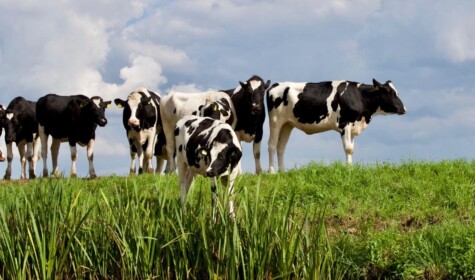At least this much is clear: the only way to tackle the climate crisis is a global effort to reduce CO2 levels in the air and to do it fast. The UK, the EU and the US have all pledged to reach a net zero target by 2050. Any approach to CO2 reduction must be two-pronged: we need to end CO2 emissions to stop the crisis from getting worse, and we have to actively reduce the amount of CO2 in the air by capturing and sequestering it, to mitigate the consequences of global warming that we are already experiencing.
Agriculture contributes to CO2 emissions but because of the ability of the soil to store carbon long term, it also offers a chance for climate mitigation. In good soil with an abundance of mycorrhiza, microorganisms and earthworms, much of the carbon that plants remove from the air through photosynthesis will bind with soil particles and thus be stored – unless the soil is ploughed or doused in pesticides. And that’s why ‘carbon farming’ – leaving the carbon rich soil structure intact – has become the new buzz word among politicians and companies as well as among farmers.
Talk to any farmer these days and chances are that they had a call, in recent months, enquiring whether they were interested in a ‘carbon farming contract’. After Brexit, with direct payments being phased out, such contracts could potentially become a new income stream. Last summer, the magazine Farmers Weekly listed no fewer than six companies offering “carbon-based payments to arable farmers” – among them start-ups as well as big players such as Bayer and Indigo Ag (last year’s number 14 on the US list of ‘disruptor’ companies, “poised to emerge from the pandemic as the next generation of billion-dollar businesses”. The reason? Companies the world over are scrambling to become carbon neutral. Even with their best efforts, most will continue to produce some CO2. In order to ‘offset’ it, they will want to or have to buy ‘carbon credits’ and these can be issued, for example, by companies that pay farmers to sequester carbon.
Not all credits are created equal
Carbon farming is such a hot topic that the Institute for Agriculture and Trade Policy (IATP), a non-profit research and advocacy organisation, chose it for a two-hour webinar at the end of March. Freya Chey from Carbon Plan, a non-profit public benefit corporation, immediately addressed what is possibly the biggest problem for any carbon credit scheme: most carbon sequestration programmes are temporary and can be easily reversed. If a farmer decides at the end of a 20-year carbon farming contract to plough, the sequestered carbon could be released again in a very short period of time. To be effective, contracts have to be long term. Last year, the Canadian government launched a federal greenhouse gas offset system that stipulates “monitoring and reporting must continue for 100 years after credits have been issued to ensure the permanence of GHG reductions”. It sounds great, says Darrin Qualman, Director of Climate Crisis Policy and Action for Canada’s National Farmers Union, but it will be very hard to enforce. Who is responsible for the monitoring? The companies that issue the contracts? It’s unlikely any of them will still exist in a hundred years’ time. What if the amount of carbon stored in the soil decreases over time? And what about the effects of natural disasters such as floods or drought? Would penalties be issued and to whom?
What’s the measure?
The only way to assess the carbon content of soils is to take soil samples and analyse them. A baseline can be established by taking a sufficient number of samples, but so far, there is no agreed model for accurately evaluating the storage of carbon over time, says Freya Chey. We know that certain agricultural practices such as planting cover crops, no-till systems or permanent pastures lead to increased carbon storage. Unfortunately, the increase is not linear but depends on a huge variety of factors including temperatures, elevation, soil type and microclimate. At one point in a 25-year study, adjacent fields were shown to be developing in opposite directions, says Qualman. And as temperatures increase, soils will release carbon, he says, even if farmers do everything right. His conclusion: there is no path to net zero with soil carbon sequestration.
So, how, if at all, should farmers be paid for carbon sequestration? One option is to reward best practices. The problem is that thorough monitoring of implementation and effectiveness is expensive. And as companies that offer carbon farming contracts will have to compete over price, those with least requirements and minimal checks will be able to offer the highest financial reward per acre. “It is an absolute race to the bottom,” says Freya Chey.
Wrong incentives
For both, the private carbon market as well as companies offering carbon contracts, “it’s the Wild West in protocols,” says Ben Lilliston, the Director of Rural Strategies and Climate Change at the IATP. Organic and regenerative farmers will have done their best to care for the soil, and the carbon content of their fields may already have plateaued – they stand to gain little. Instead, carbon contracts are likely to reward industrial farming: fields with very depleted soils will store carbon rapidly once the management practices change. And, of course, it is much more efficient to have a few ‘big’ contracts for several hundred or even thousands of hectares than manage numerous small ones.
For industrial farm businesses, ‘carbon credits’ are just another commodity they produce. And for a lot of companies, carbon credits are already big business. Andrea Beste is a German soil scientist and author of a recent study on greenwashing. She calls carbon sequestration a good concept, misappropriated for greenwashing. “At the climate summit in New York in September 2019, 19 global corporations formed a coalition for ‘alternative farming practices’. They call it ‘One Planet Business for Biodiversity’. Danone initiated the coalition. Among the members are the Kellogg Company, L’Oreal, Mars, Nestlé, Unilever and Yara. The initiative introduces ‘regenerative agriculture’ as a basic term. PepsiCo is another example. In April 2021, the group announced the 2030 target to expand ‘regenerative farming practices’ to 7 million hectares, and once again organic farming is not part of the solution.”
In the US, California is known for its strict environmental legislation. In 2014, the state introduced cap and trade auctions of permits to force industries to either reduce their CO2 emissions or pay to offset them. At the same time, the decision was made to invest part of the proceeds into projects such as the ‘Healthy Soils’ initiative. It avoids potential rows over soil carbon measurements and how to financially reward farmers by incentivising environmentally friendly agricultural practices which increase the potential for carbon sequestration. The application process for grant money is complicated, only new on-farm projects are being funded, and the funding needs to be scaled up because there isn’t enough money for all projects that fulfil the criteria. But ‘Healthy Soils’ has two big advantages over carbon farming contracts: it incentivises good farming practices and the resulting carbon sequestration is simply seen as an additional benefit.
Food vs. energy
Achieving net zero by 2050 will only be possible if carbon sequestration in soils and carbon credits are not seen as a license to continue the use of energy from fossil fuels. The race is on to find new sources for clean energy.
In the UK, energy companies are now competing with farmers over agricultural land. In particular, the flat areas in eastern England which are ideal for growing arable crops are also best suited for solar farms. A recent article in The Guardian took stock: “Finlay Colville, head of research at Solar Media, a business intelligence and digital media firm, said there are now about 910 possible solar farm projects in the pipeline in the UK, with numbers about to increase by about a third in 2021. More than 300 have already submitted planning applications or have already been approved.” The major concern is, of course, that farmland will be taken out of production right at the time when concerns about food security are growing. There now seems to be a consensus among scientists in the EU that growing crops for the production of biofuels is unsustainable and greenwashing. “Whereas plants convert solar energy into energy packets by way of organic molecules in order to store it, normal photovoltaics requires only the first step, the conversion of energy to animated electrons. Even with the most unfavourable calculation, a photovoltaic system requires only one tenth of the arable land that is required for the cultivation of energy crops”, writes Beste. And solar farms need not be in competition with food production: “A dual use of energy production and nature conservation-oriented extensive agriculture, such as grazing sheep, is possible with PV systems. Ground-mounted photovoltaic systems can now be installed vertically or seamlessly integrated into fields for growing arable or specialty crops, thus avoiding competition over land use for food production. In this way, agriculture can even be combined with energy production.” That solar panels, in particular whole fields of them, are an eyesore, is a different topic.



